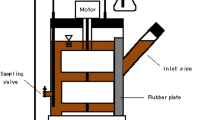Abstract
Heterotrophic denitrification of drinking water was enhanced by selection of an anoxic sludge taken from a dairy industry among the sludges taken from various industries, and the effect of carbon sources was examined. Acclimatization to high nitrate concentration was then carried out in a five-stage process. Considering removals of both nitrate and nitrite, the sludge taken from anoxic unit of Tehran Pegah dairy industry was shown to be the superior microbial culture, with ethanol as carbon source as compared to acetate. To enhance the rate of denitrification, acclimatization to nitrate (at 100, 200, 400, 800, and 1,600 mg N-NO3/L) was carried out in sequencing batch reactors over a 3-month period under anoxic condition, and comparisons were made between the performances of acclimated and non-acclimated sludges at each stage. It was found that acclimatization up to the fourth stage enhanced the specific denitrification rate to a high value of 29.6 mg N-NO3/h/g mixed liquor suspended solids (MLSS), with no significant nitrite accumulation. Additionally, the effect of initial pH (6, 6.5, 7, and 7.5) and carbon-to-nitrogen (C/N) ratio (1, 1.5, 2, and 3) on the performance of this final acclimated sludge was assessed, where initial pH of 7 and C/N ratio of 1.5 resulted in the best performances considering both nitrate and nitrite removal.







Similar content being viewed by others
References
Wang, X., & Wang, J. (2009). Science in China, Series B: Chemistry, 52, 236–240.
Chu, L., & Wang, J. (2013). Chemosphere, 91, 1310–1316.
Calderer, M., Gibert, O., Martí, V. V., Rovira, M. M., de Pablo, J., Jordana, S., & Dur, L. (2010). Environmental Technology, 31, 799–814.
Cheikh, A., Yala, A., Drouiche, N., Abdi, N., Lounici, H., & Mameri, N. (2013). Ecological Engineering, 53, 329–334.
Gilchrist, M., Winyard, P. G., & Benjamin, N. (2010). Nitric Oxide, 22, 104–109.
Li, H., Zhou, S., Sun, Y., & Lv, J. (2010). Bioresource Technology, 101, 7736–7743.
Noophan, P., Paopuree, P., Kanlayaras, K., Sirivithayapakorn, S., & Techkarnjanaruk, S. (2009). Environment Asia, 2, 30–35.
Jagessar, R. C., & Alleyne, O. (2011). International Journal of Academic Research, 3, 443–453.
S.r. Warneke, L.A. Schipper, M.G. Matiasek, K.M. Scow, S. Cameron, D.A. Bruesewitz, I.R. (2011). Water Research, 45, 5463–5475.
Ghafari, S., Hasan, M., & Aroua, M. K. (2008). Bioresource Technology, 99, 3965–3974.
Upadhyaya, G., Jackson, J., Clancy, T. M., Hyun, S. P., Brown, J., Hayes, K. F., & Raskin, L. (2010). Water Research, 44, 4958–4969.
Liu, H., Jiang, W., Wan, D., & Qu, J. (2009). Journal of Hazardous Materials, 169, 23–28.
Della Rocca, C., Belgiorno, V., & Meric, S. (2007). Desalination, 204, 46–62.
Luk, G. K., & Au-Yeung, W. C. (2002). Advances in Environmental Research, 6, 441–453.
Gomez, M. A., Hontoria, E., & Gonzalez-Lopez, J. (2002). Journal of Hazardous Materials, 90, 267–278.
Robinson-Lora, M. A., & Brennan, R. A. (2009). Bioresource Technology, 100, 534–541.
Fuchs, W., Schatzmayr, G., & Braun, R. (1997). Applied Microbiology and Biotechnology, 48, 267–274.
Adouani, N., Lendormi, T., Limousy, L., & Sire, O. (2010). Resources, Conservation and Recycling, 54, 299–302.
Ovez, B., Ozgen, S., & Yuksel, M. (2006). Process Biochemistry, 41, 1539–1544.
Upadhyaya, G. (2010). PhD thesis, environmental engineering. US: University of Michigan.
van Rijn, J., Tal, Y., & Schreier, H. J. (2006). Aquacultural Engineering, 34, 364–376.
Schipper, L. A., Robertson, W. D., Gold, A. J., Jaynes, D. B., & Cameron, S. C. (2010). Ecological Engineering, 36, 1532–1543.
Suhr, K. I., Pedersen, P. B., & Arvin, E. (2013). Aquacultural Engineering, 53, 57–64.
Guven, D. (2009). Clean, 37, 565–573.
Gavazza Dos Santos, S., Amancio Varesche, M. B., Zaiat, M., & Foresti, E. (2004). Environmental Engineering Science, 21, 313–320.
Glass, C., & Silverstein, J. (1998). Water Research, 32, 831–839.
Foglar, L., Bolf, N., & Lukic, M. (2010). WSEAS Transactions on Environment and Development, 6, 375–384.
Wu, J. S., Langley, W. G., & Chao, A. C. (2001). Journal of Environmental Engineering, 127, 689–697.
Hunt, P. G., Matheny, T. A., Ro, K. S., & Stone, K. C. (2008). Journal of Environmental Science and Health, Part A, 43, 1077–1084.
Dhamole, P. B., Nair, R. R., D’Souza, S. F., & Lele, S. S. (2007). Bioresource Technology, 98, 247–252.
Dhamole, P. B., Nair, R. R., D’Souza, S. F., & Lele, S. S. (2008). Applied Biochemistry and Biotechnology, 151, 433–440.
Glass, C., & Silverstein, J. (1999). Water Research, 33, 223–229.
Nair, R. R., Dhamole, P. B., & Lele, S. S. (2008). Applied Biochemistry and Biotechnology, 151, 193–200.
American Public Health Association (APHA), Standard methods for the examination of water and wastewater, 19th ed., Washington.
Strong, P. J., McDonald, B., & Gapes, D. J. (2011). Bioresource Technology, 102, 5533–5540.
Mekonen, A., Kumar, P., & Kumar, A. (2001). Journal of Environmental Engineering, 127, 273–278.
Ravindran, V., Tsai, H.–. H., Williams, M. D., & Pirbazari, M. (2009). Journal of Membrane Science, 344, 39–54.
Shen, Z., Zhou, Y., & Wang, J. (2013). Bioresource Technology, 131, 33–39.
Gayle, B. P., Boardman, G. D., Sherrard, J. H., & Benoit, R. E. (1989). Journal of Environmental Engineering, 115, 930–943.
Fernandes, H., Jungles, M. K., Hoffmann, H., Antonio, R. V., & Costa, R. H. R. (2013). Bioresource Technology, 132, 262–268.
R.R.D. Nair, P.B.D. Dhamole, S.F.D. DSouza. (2010). Proceedings of the Annual International Conference on Soils, Sediments, Water and Energy, India.
Lorrain, M. J., Tartakovsky, B., Peisajovich-Gilkstein, A., & Guiot, S. R. (2004). Environmental Technology, 25, 1041–1049.
Gomez, M. A., Gonzalez-Lopez, J., & Hontoria Garcia, E. (2000). Journal of Hazardous Materials, 80, 69–80.
Lu, H., & Chandran, K. (2010). Biotechnology and Bioengineering, 106, 390–398.
Martin, D., Salminen, J. M., Niemi, R. M., Heiskanen, I. M., Valve, M. J., Hellstén, P. P., & Nystén, T. H. (2009). Journal of Hazardous Materials, 163, 1230–1238.
Liao, R., Shen, K., Li, A.-M., Shi, P., Li, Y., Shi, Q., & Wang, Z. (2013). Bioresource Technology, 134, 190–197.
Cherchi, C., Onnis-Hayden, A., El-Shawabkeh, I., & Gu, A. Z. (2009). Water Environment Research, 81, 788–799.
Bilanovic, D., Battistoni, P., Cecchi, F., Pavan, P., & Mata-Alvarez, J. (1999). Water Research, 33, 3311–3320.
Zhao, Y., Feng, C., Wang, Q., Yang, Y., Zhang, Z., & Sugiura, N. (2011). Journal of Hazardous Materials, 192, 1033–1039.
Srinandan, C. S., D’souza, G., Srivastava, N., Nayak, B. B., & Nerurkar, A. S. (2012). Bioresource Technology, 117, 292–299.
Nuhoglu, A., Pekdemir, T., Yildiz, E., Keskinler, B., & Akay, G. (2002). Water Research, 36, 1155–1166.
Isaka, K., Kimura, Y., Osaka, T., & Tsuneda, S. (2012). Water Research, 46, 4941–4948.
Mohseni-Bandpi, A., & Elliott, D. J. (1998). Water Science and Technology, 38, 237–243.
Author information
Authors and Affiliations
Corresponding author
Rights and permissions
About this article
Cite this article
Akbari Shahabi, Z., Naeimpoor, F. Enhanced Heterotrophic Denitrification: Effect of Dairy Industry Sludge Acclimatization and Operating Conditions. Appl Biochem Biotechnol 173, 741–752 (2014). https://doi.org/10.1007/s12010-014-0884-4
Received:
Accepted:
Published:
Issue Date:
DOI: https://doi.org/10.1007/s12010-014-0884-4




